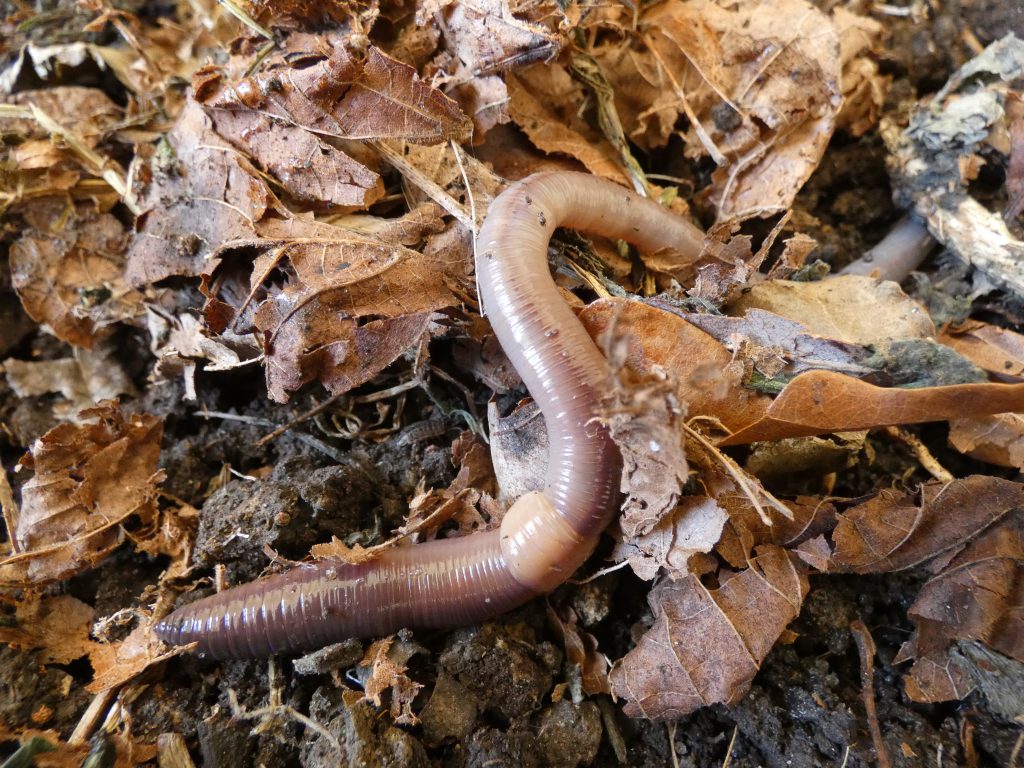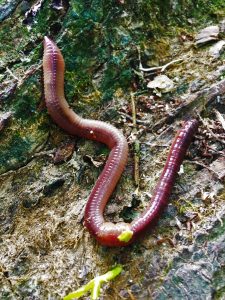
…guest blog from Keiron Brown, recording Officer at the Earthworm Society of Britain
In the British Isles we have 31 species of native or naturalised earthworms. Perhaps the most iconic of these is Lumbricus terrestris, otherwise known as the Lob Worm, Common Earthworm or, across the pond, the Nightcrawler.
Biology
The Lob Worm is the largest species of earthworm found in the British Isles and can grow to a whopping 40 cm, making it one of the largest terrestrial invertebrates that we have.

Like other earthworms they are simultaneous hermaphrodites, meaning that they possess both male and female reproductive parts and perform the role of the male and female when mating with another earthworm. Mating results in the production of an earthworm cocoon, which usually contains just a single fertilised egg and where a young earthworm can develop safely until it’s ready to hatch. Lob Worms reach sexually maturity after around 1 year and adults are easily recognisable by the fleshy band known as a saddle or clitellum.
Lob worms do not have ears or eyes but are able to detect light and vibrations. Like humans, they have haemoglobin so their blood is red – unlike most other invertebrates. To pump the blood around their bodies they have a simple circulatory system with 5 pairs of “pseudohearts”. They do not have lungs, and instead breath through the moisture layer on the skin – hence their need to inhabit damp environments and avoid drying out.
Ecology
Alongside the other larger species of British earthworm, the Lob Worm is an anecic species, meaning that it is deep burrowing and feeds on a combination of nutrient-poor deep soil and surface leaf litter. Within the digestive of system of the worm, these are combined with enzymes and bacteria to produce earthworm casts (or poo) and deposited on the surface – earning this species the title of “nature’s plough”.

Lob Worms create deep vertical burrows that they will line with mucus to allow quick movement up and down the soil profile. These burrows are permanent homes for the worms and enable their main defence from above ground predators – a rapid retreat deep into the soil.
Behaviour
The Lob Worm is probably the most studied species of earthworm in the British Isles, and possibly even the world. One of the first scientists to take interest in this ecosystem engineer was none other than Charles Darwin. Darwin was fascinated by earthworms and his research included investigating the behaviour of the Lob Worm with relation to its middens.
A midden is a pile of miscellaneous material used to block up the entrance to a Lob Worm burrow, It’s believed that this behaviour is to protect the entrance of the burrow, particularly from the elements and to prevent the animal from drying out. Middens are constructed from whatever the earthworm can find (such as leaves, twigs and small stones) alongside their casts. Darwin found that if their middens were removed, Lob Worms would rebuild them the following evening to protect their burrows during the following day.
Lob Worms tend to remain underground during the day, to avoid drying out and predation, and surface at night to mate and collect decaying leaves that they will pull down into their burrows for consumption at a later date. It’s this nocturnal surfacing behaviour that has earned the Lob Worm it’s American common name: the Nightcrawler.
Threats

As with other earthworm species, threats to the Lob Worm include pesticides (any chemicals that make their way into the soil inevitably end up in earthworms) and intensive agricultural practices (ploughing destroys the burrow systems of these animals and can cause physical damage if they are chopped in half). Although some earthworm species have fantastic regenerative abilities, the Lob Worm has a very poor capacity for regrowth of lost segments. Therefore, the old wives tale that if you chop an earthworm in half it results in two worms is unlikely to be true as only the head end is likely to be able survive and even that depends on how damaged the earthworm is. Worms severed between the saddle and the head are unlikely to survive at all.
Another threat comes from the colonisation of the British Isles by non-native invasive species of terrestrial flatworm. The New Zealand Flatworm (Arthurdendyus triangulatus) is of particular concern as it is known to predate the Lob Worm and, unlike the many native predators of this species, can follow the earthworm down its burrow and consume the worm within its home.
Find out more
- Find out more about earthworm ecology from the Earthworm Society of Britain website
- Hear about exciting research to understand UK earthworm in a free entoLIVE webinar ~ Wriggling Into Recording: 10 Years of the National Earthworm Recording Scheme
- Learn about non-native invasive flatworms and report them through the Buglife Flatworm Survey
- Did you know that the Lob Worm was named as one of the10 species that can help save the world in a report publish in March 2022?
COP15
Between the 7th and 19th of December nations will gather in Montreal, Canada at COP15.
- ‘COP’ simply stands for the Conference of the Parties of an international convention and, this is the one for biodiversity (COP15). The numbers indicate how many times the parties have met.
- The Convention of Biological Diversity (CBD) looks to secure targets to ensure the survival of biodiversity across the world.
What invertebrates need COP15 to commit to:
- Halt and reverse the loss of biodiversity by 2030, setting goals that will prevent extinctions, recover species populations, and retain and restore habitats
- Protect at least 30% of land and sea for nature by 2030 in a fair and effective way
- Set 2030 targets that will reduce the negative pressures humans put on nature globally by 50%, including from pollution, and the unsustainable use of natural resources
- This must include reduction of pollutants such as light pollution, pharmaceuticals, and pesticides
- Reduction in the spread of Invasive Non-Native Species
- Provide the money and resources needed to restore nature, whilst empowering local people and indigenous communities, and holding countries accountable for their actions

